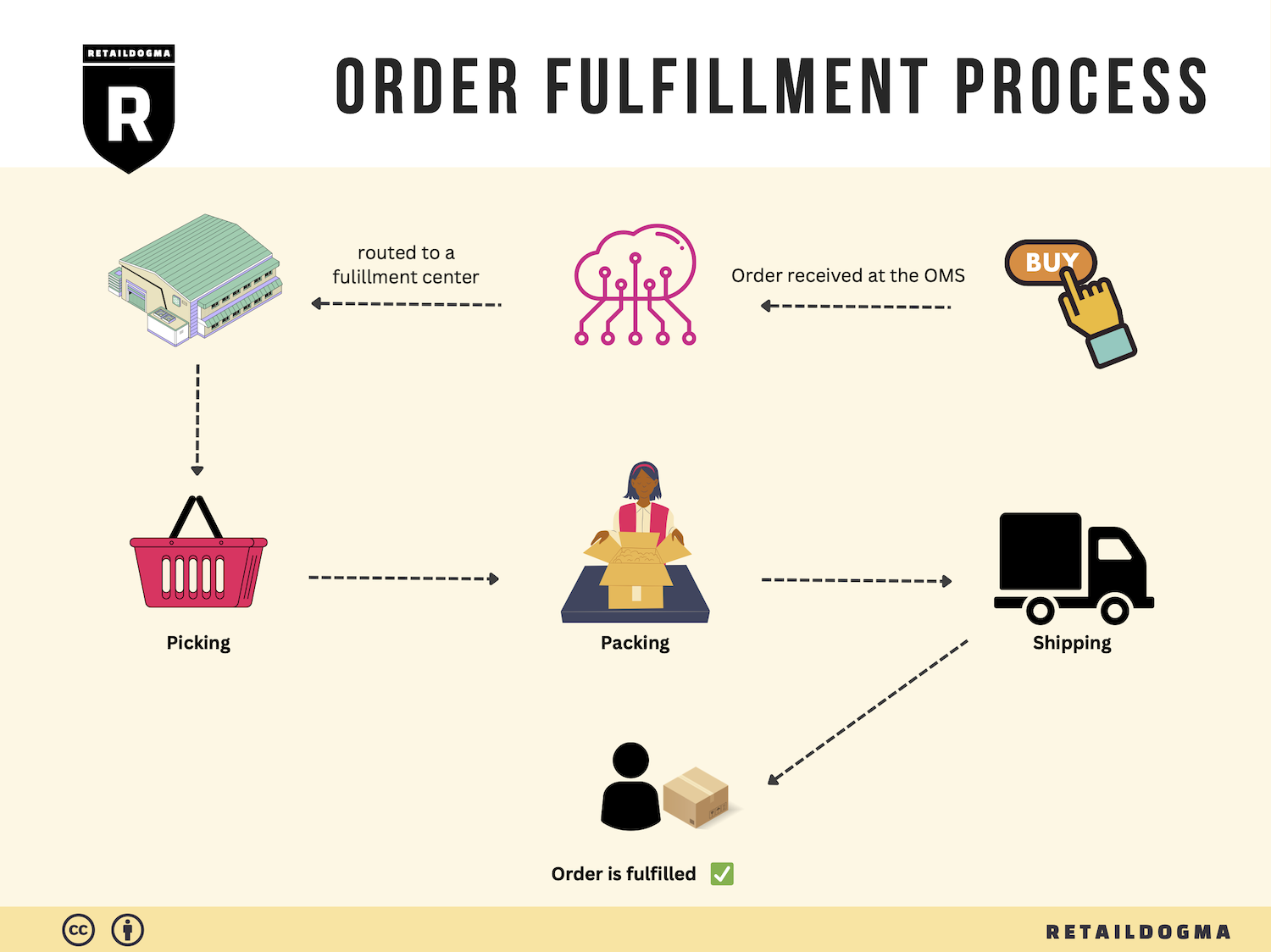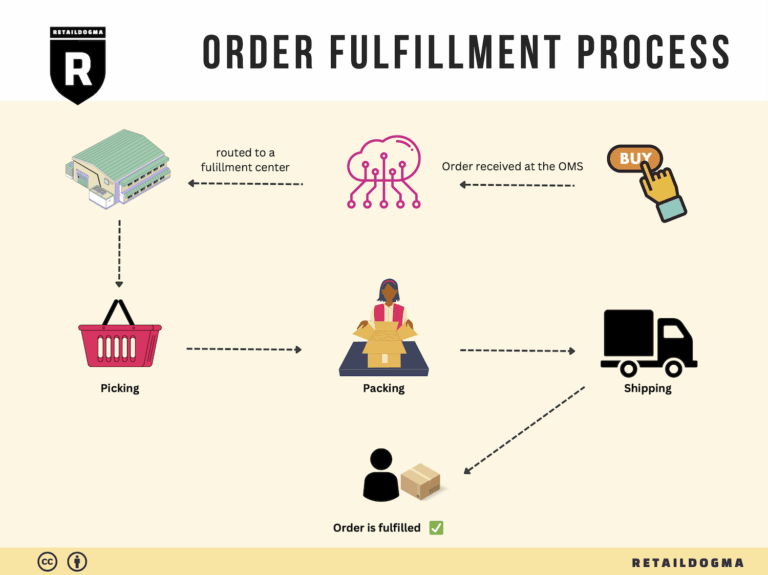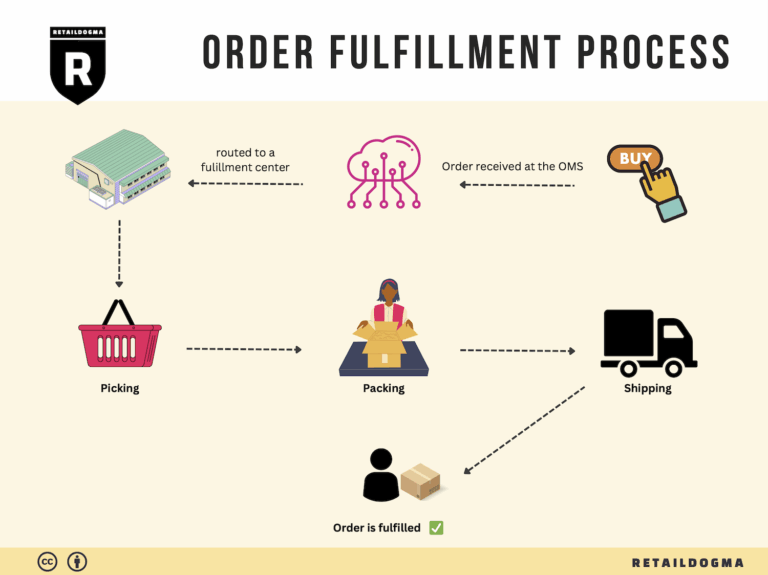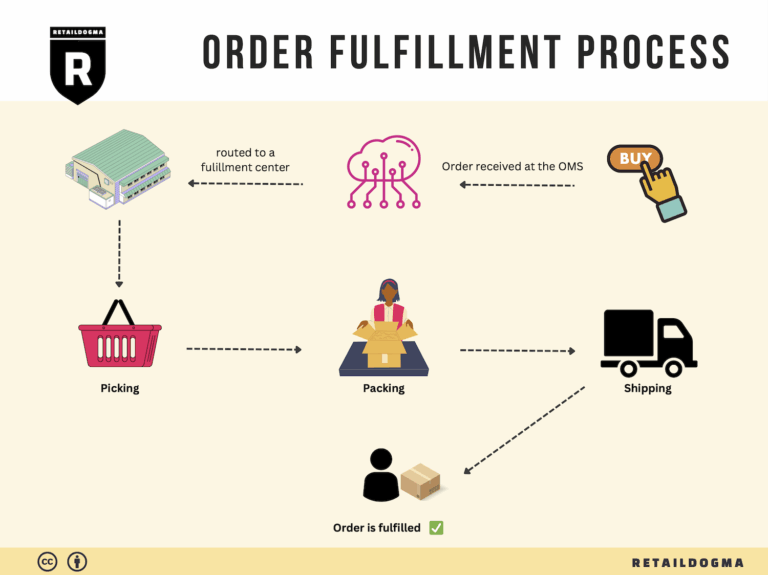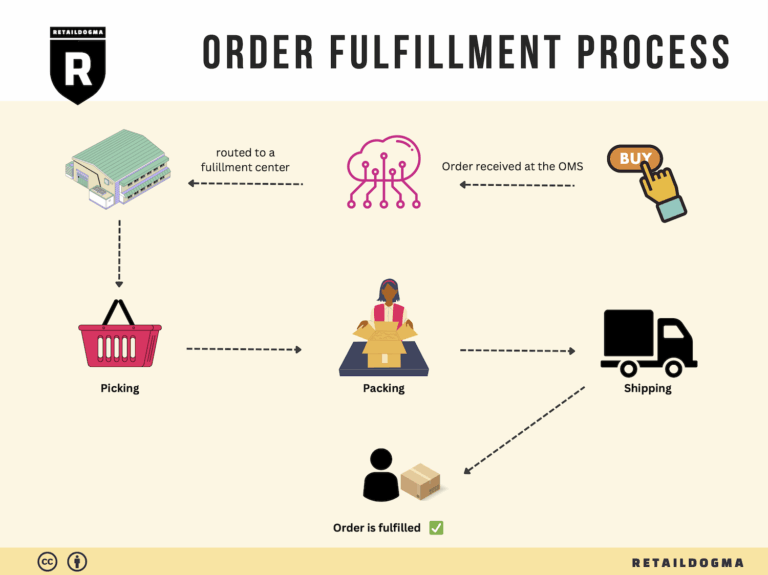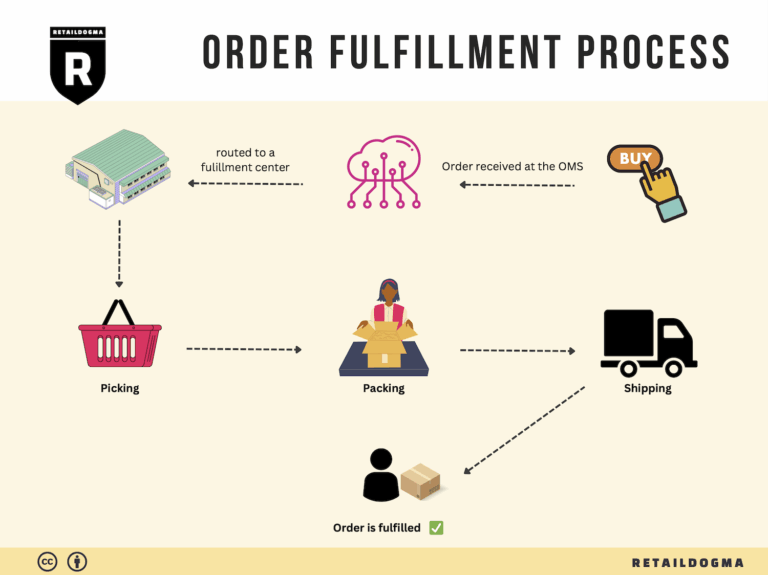Ecommerce Fulfillment Services: The Ultimate Guide (2025)
What is E-commerce Fulfillment? An Introduction for Growing Businesses
Understanding E-commerce Fulfillment
As an e-commerce business owner, you might find yourself drowning in the complexities of packing and shipping orders. This overwhelming aspect of logistics can quickly consume your time and energy, pulling your focus away from growing your brand and improving your customer experience. The good news is that you don’t have to navigate this maze alone. Understanding e-commerce fulfillment can empower you to streamline your operations and enhance your service offerings.
At its core, fulfillment is the process of getting a product from your inventory to your customer’s doorstep. This process encompasses several key stages, including receiving inventory, storing products, picking and packing orders, and shipping them out. For growing businesses, the fulfillment strategy you choose can significantly impact your scalability and customer satisfaction.
In this guide, we will explore various fulfillment models available to e-commerce businesses, including Third-Party Logistics (3PL) and Fulfillment by Amazon (FBA). Each model has its unique advantages and challenges, so understanding the nuances will help you make informed decisions that align with your business goals.
We’ll also delve into the core services associated with e-commerce fulfillment. This includes warehousing, order processing, inventory management, and shipping. By understanding these services, you’ll be better equipped to evaluate potential partners and find solutions that meet your specific needs.
Choosing the right fulfillment partner is crucial for your business. We will discuss key considerations to keep in mind, such as the partner’s reliability, technology integration capabilities, and customer service standards. This section will guide you through the evaluation process, helping you identify a partner who not only meets your operational needs but also aligns with your brand values.
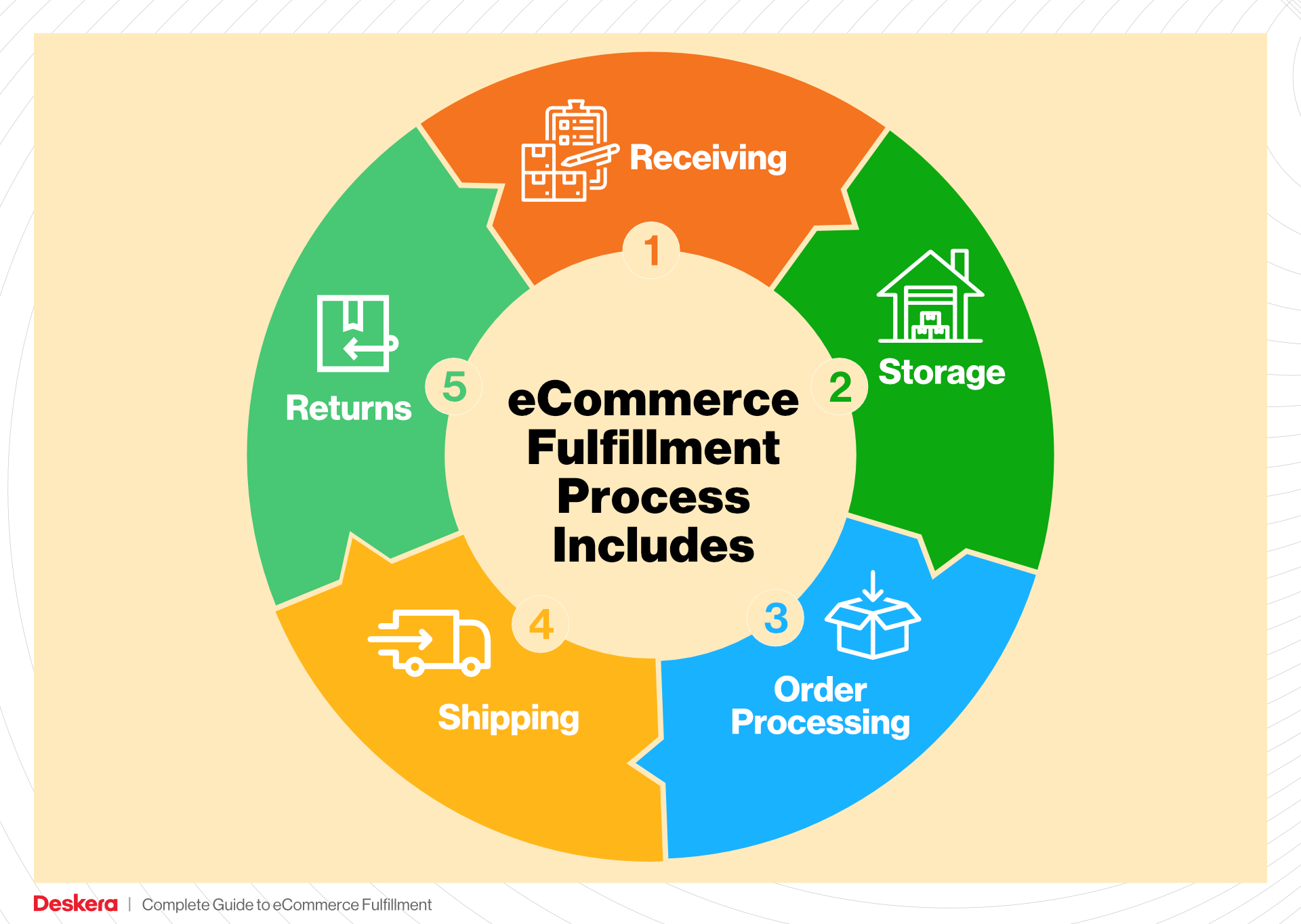
Additionally, we will cover pricing structures commonly found in fulfillment services. Understanding the costs involved—from storage fees to shipping rates—will enable you to create a budget that maximizes your profit margins while ensuring efficient service delivery.
The ultimate goal of this guide is to empower you, as a business owner, to make smart logistics decisions that enhance your operational efficiency and customer satisfaction. By leveraging the right fulfillment strategy, you can reduce overwhelm, focus on growth, and build a loyal customer base that keeps coming back.
What You’ll Learn In This Guide
- What is E-commerce Fulfillment? An Introduction for Growing Businesses
- The Order Fulfillment Process: From ‘Buy’ Button to Customer’s Door
- Comparing Fulfillment Models: In-House vs. 3PL vs. Dropshipping
- A Deep Dive into Amazon FBA: Pros, Cons, and Who It’s For
- Core Services Offered by Fulfillment Centers
- How to Choose a Fulfillment Partner: A 6-Point Checklist
- Understanding Fulfillment Pricing: A Breakdown of Common Fees
- Frequently Asked Questions (FAQs) about Fulfillment
- Conclusion: Is Outsourcing Fulfillment the Right Move for Your Business?
- Important Disclaimer
The Order Fulfillment Process: From ‘Buy’ Button to Customer’s Door
1. Receiving Inventory
The order fulfillment process begins with receiving inventory, which is the crucial first step in ensuring that your e-commerce business is stocked and ready to meet customer demand. During this stage, products are delivered from suppliers or manufacturers to the warehouse.
Once the shipment arrives, it is essential to conduct a thorough inspection to verify that the quantity and quality of items match the purchase orders. This process often involves the use of Stock Keeping Units (SKUs), which are unique identifiers for each product. SKUs help streamline inventory management, making it easier to track items throughout the fulfillment process.
Effective inventory receiving is vital for maintaining accurate stock levels, minimizing discrepancies, and preventing stockouts, which can lead to lost sales and customer dissatisfaction. By ensuring that all received items are accounted for and correctly logged into your inventory management system, you lay a solid foundation for the subsequent steps in the fulfillment process.
2. Warehouse Storage
Once inventory is received, the next step is warehouse storage. This involves strategically placing products in designated areas within the warehouse to optimize space and facilitate efficient order processing. Proper organization is key, as it directly impacts the speed and accuracy of order fulfillment.
In this stage, businesses often employ a system of categorization, such as zone picking or bin shelving, to enhance accessibility. Utilizing inventory management software can help track the location of each item, ensuring that employees can easily retrieve products when orders come in.
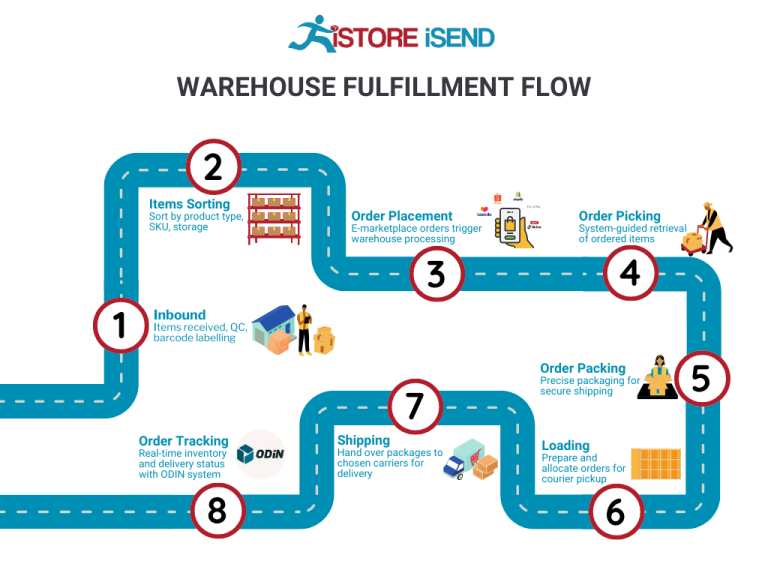
Effective warehouse storage is crucial for minimizing retrieval times and reducing labor costs. A well-organized warehouse can significantly enhance the overall efficiency of your operations, allowing your business to scale effectively while meeting customer expectations.
3. Order Picking
Order picking is the process of selecting items from the warehouse to fulfill customer orders. When a customer places an order, a pick list is generated, detailing the items and their respective locations within the warehouse. This list serves as a guide for warehouse staff to efficiently collect the required products.
There are several picking methods available, including single order picking, batch picking, and wave picking. Each method has its advantages and is chosen based on order volume and warehouse layout. For example, batch picking allows employees to collect multiple orders simultaneously, which can significantly increase efficiency during peak seasons.
The importance of effective order picking cannot be overstated; it directly impacts order accuracy and customer satisfaction. Mistakes during this stage can lead to incorrect shipments, resulting in returns and increased operational costs. By investing in training and using technology like barcode scanners, businesses can enhance picking accuracy and streamline their fulfillment processes.
4. Order Packing
After items have been picked, the next step is order packing. This involves preparing the selected products for shipment by securely packing them in boxes or envelopes. Proper packing is critical to ensure that items arrive at the customer’s door undamaged.
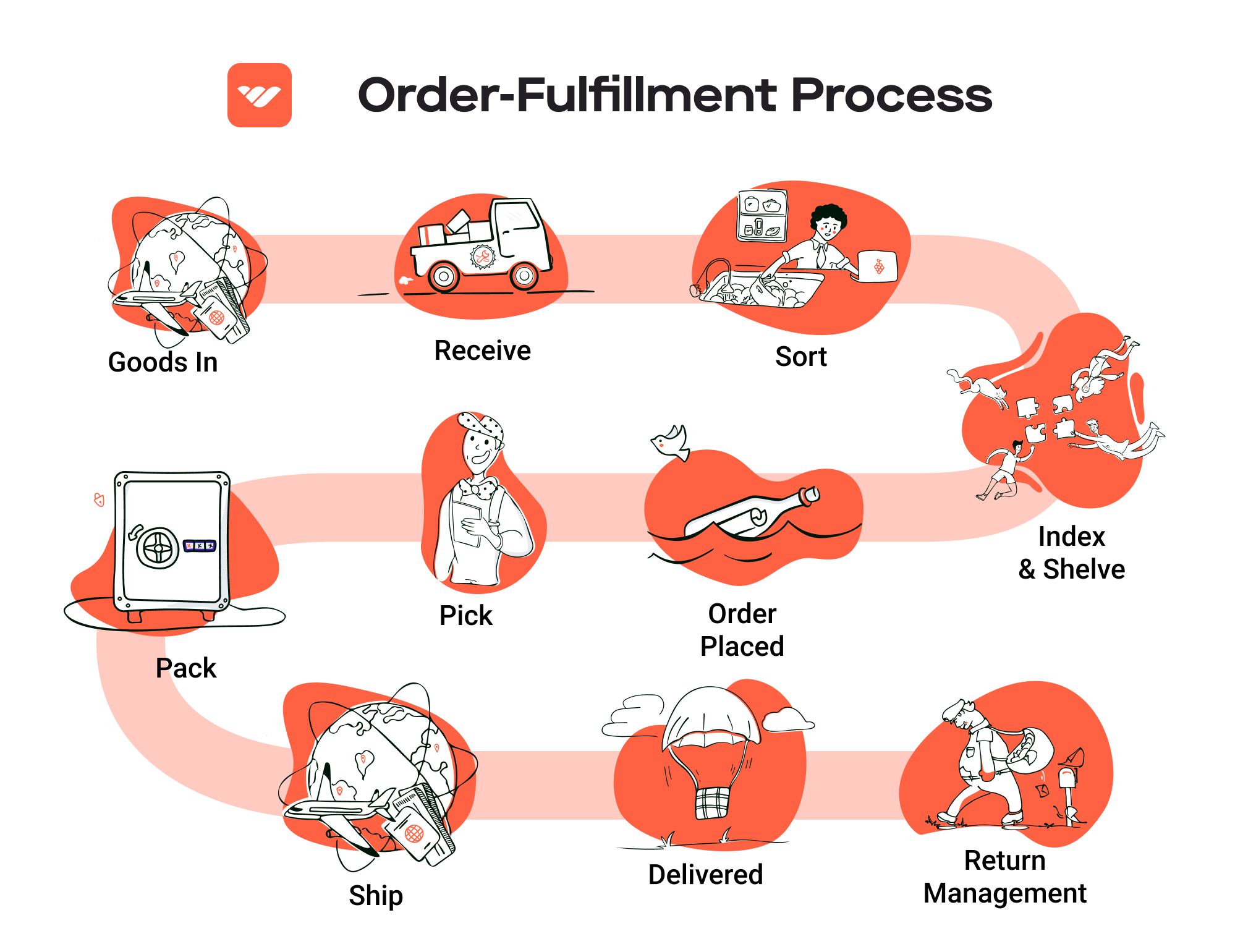
During this phase, it is important to consider packaging materials, such as bubble wrap, packing peanuts, or custom-sized boxes, to protect the items during transit. Additionally, businesses should include packing slips and any promotional materials to enhance the customer experience.
Efficient packing processes can save time and reduce shipping costs. Utilizing packing software can automate the selection of appropriate box sizes and materials based on the order contents, streamlining the packing process. By prioritizing careful and efficient packing, businesses can improve customer satisfaction and reduce the likelihood of returns.
5. Shipping & Delivery
The final step in the order fulfillment process is shipping and delivery. Once orders are packed, they are labeled and handed over to shipping carriers for delivery to customers. This stage involves selecting the most cost-effective and timely shipping options, which can vary based on customer location and shipping preferences.
Tracking shipments is a key aspect of this step, as it provides customers with real-time updates on their order status. Implementing a robust tracking system can enhance transparency and build trust with customers, as they appreciate knowing when to expect their orders.
Effective shipping and delivery are crucial for maintaining a positive customer experience. Delays or mishandling can lead to dissatisfaction and damage your brand’s reputation. By working closely with reliable shipping partners and continuously optimizing shipping routes and methods, businesses can ensure timely deliveries and foster customer loyalty, which is essential for scaling operations successfully.
Comparing Fulfillment Models: In-House vs. 3PL vs. Dropshipping
Fulfillment Model Comparison
| Model | Who Handles Inventory | Best For (Business Stage) | Key Advantage | Key Disadvantage |
|---|---|---|---|---|
| In-House Fulfillment | The business itself | Established businesses | Complete control over inventory and processes | High overhead costs and resource-intensive |
| Third-Party Logistics (3PL) | A third-party provider | Growing businesses | Scalability and reduced operational burden | Less control over inventory and shipping |
| Dropshipping | Supplier or manufacturer | Startups or small businesses | Low startup costs and minimal risk | Lower profit margins and potential quality issues |
In-House Fulfillment
In-house fulfillment involves managing the storage, processing, and shipping of products within your own facilities. This model is typically adopted by established businesses that have the resources and infrastructure to handle logistics internally. The primary advantage of in-house fulfillment is the high degree of control it offers. Businesses can closely manage inventory levels, order processing, and customer service, leading to potentially enhanced customer satisfaction. However, this model can also be resource-intensive, requiring significant investment in warehousing, staffing, and technology. As businesses grow, these overhead costs can become a burden, making it essential to evaluate whether the benefits of control outweigh the financial implications.
Third-Party Logistics (3PL)
Third-party logistics (3PL) providers offer outsourced logistics services that include transportation, warehousing, and order fulfillment. This model is particularly advantageous for growing businesses that are scaling operations and looking to optimize their supply chain without the burden of managing logistics directly. By partnering with a 3PL, businesses can leverage the provider’s expertise, technology, and network, allowing for improved efficiency and scalability. However, one of the key disadvantages is the reduced control over inventory and shipping processes. Businesses must rely on their 3PL partner to maintain quality standards and ensure timely deliveries, which can be challenging if the relationship is not well-managed. Ultimately, 3PLs can provide a strategic advantage in the competitive landscape, but it requires careful selection and ongoing communication to ensure alignment with business goals.
Dropshipping
Dropshipping is a fulfillment model where the retailer does not keep products in stock. Instead, when a customer places an order, the retailer purchases the item from a third-party supplier who then ships it directly to the customer. This model is particularly appealing for startups or small businesses looking to minimize upfront investment and operational risk. The key advantage of dropshipping is the low barrier to entry; businesses can offer a wide range of products without the need for significant inventory or warehousing costs. However, this model also comes with its challenges. Profit margins can be lower due to reliance on suppliers, and there may be issues with product quality and shipping times that are beyond the retailer’s control. As such, while dropshipping can be an attractive option for new entrants, it is crucial to choose reliable suppliers and maintain a strong focus on customer service to mitigate potential downsides.
Conclusion
Choosing the right fulfillment model is essential for e-commerce success and depends largely on the specific needs and stage of your business. In-house fulfillment offers control at a cost, 3PL provides scalability with some loss of oversight, and dropshipping allows for low-risk entry into the market. Each model has its unique advantages and disadvantages, and business owners must weigh these factors carefully to select the best approach for their operations. As your business evolves, it may also be necessary to reassess your fulfillment strategy to ensure it aligns with your growth objectives and customer expectations.
A Deep Dive into Amazon FBA: Pros, Cons, and Who It’s For
Understanding Fulfillment by Amazon (FBA)
Fulfillment by Amazon (FBA) is a service provided by Amazon that allows e-commerce sellers to store their products in Amazon’s fulfillment centers. Amazon then takes care of storage, packaging, shipping, and customer service for these products. This service enables sellers to leverage Amazon’s extensive logistics network, ensuring that their products reach customers quickly and efficiently.
When a customer orders a product, Amazon handles the entire process—from picking the product off the shelf to shipping it directly to the customer’s doorstep. Sellers benefit from Amazon’s advanced logistics capabilities, which include the option for products to be eligible for Amazon Prime, thereby enhancing visibility and sales potential.
How FBA Works
-
Product Preparation: Sellers send their products to Amazon’s fulfillment centers. Proper preparation and labeling are crucial to ensure that products meet Amazon’s requirements.
-
Storage: Once received, products are stored in Amazon’s warehouses. Amazon manages the inventory, keeping track of stock levels and product conditions.
-
Order Fulfillment: When a customer places an order, Amazon picks, packs, and ships the product on behalf of the seller. This process is designed to be quick and efficient, often resulting in same-day or next-day delivery for Prime members.
-
Customer Service: Amazon also handles all customer inquiries and returns related to FBA products. This means that sellers can focus on other aspects of their business without worrying about customer service logistics.
-
Fees: Sellers pay for the storage and fulfillment services. These fees vary based on the size and weight of the products, as well as the time of year (e.g., increased fees during peak seasons).
Pros of Using FBA
1. Prime Eligibility
Products fulfilled through FBA are eligible for Amazon Prime, which can significantly boost visibility and sales. Prime members are more likely to purchase items that offer free and fast shipping, making FBA an attractive option for sellers looking to tap into this customer base.
2. Increased Customer Trust
Selling through Amazon provides an inherent level of credibility. Customers often trust Amazon’s fulfillment service, which can lead to higher conversion rates. The reliable shipping and customer service associated with FBA can enhance a seller’s reputation.
3. Multi-Channel Fulfillment
FBA allows sellers to fulfill orders not only from Amazon but also from other sales channels, such as eBay or their own websites. This flexibility enables sellers to centralize their logistics operations, making it easier to manage inventory across multiple platforms.
4. Scalability
FBA can support rapid growth. As your business expands, you can scale up your inventory without worrying about the logistics of storage and fulfillment. Amazon’s infrastructure is designed to accommodate increased demand, allowing sellers to focus on growth strategies.
5. Automation of Logistics
With FBA, sellers can automate many aspects of their logistics, from inventory management to shipping. This automation can lead to cost savings and more efficient operations, freeing up time for sellers to concentrate on marketing and product development.
Cons of Using FBA
1. High Fees
While FBA provides numerous advantages, it also comes with costs. Sellers must pay for storage and fulfillment, which can add up, especially for larger or slower-moving items. These fees can significantly impact profit margins if not carefully managed.
2. Strict Inventory Rules
Amazon has specific guidelines regarding inventory management. Sellers must adhere to these rules or face penalties, such as removal fees for excess inventory or restrictions on selling certain products. This can create challenges for businesses that struggle to predict demand accurately.
3. Commingling Risks
FBA products may be commingled with other sellers’ inventory. While this can streamline operations, it also poses risks. If a customer returns a product, it may not be clear which seller the item belongs to. This can lead to potential losses or damage to a seller’s reputation if a returned item does not meet quality expectations.
4. Loss of Control Over Shipping
When using FBA, sellers relinquish control over the shipping process. While this can be a pro, it may also lead to concerns about shipping times and the condition of products upon arrival. Sellers must trust Amazon’s logistics network and quality control.
5. Limited Customization
FBA does not allow for much customization in packaging or branding. Sellers looking to create a unique unboxing experience may find FBA limiting, as all products are packaged according to Amazon’s standards.
Who is FBA Best For?
Fulfillment by Amazon is particularly well-suited for:
-
Small to Medium-Sized Businesses: Those looking to scale operations without investing heavily in logistics infrastructure can benefit greatly from FBA. It allows them to focus on product development and marketing.
-
E-commerce Entrepreneurs: New sellers entering the e-commerce space can leverage FBA to establish credibility and streamline fulfillment processes, enabling them to compete with larger retailers.
-
Brands with Established Products: Businesses with proven products that have consistent demand can take advantage of FBA to manage logistics efficiently and maximize their reach.
-
Sellers with Limited Resources: Companies lacking the capital or expertise to manage their own logistics can utilize FBA to access Amazon’s robust fulfillment network.
In conclusion, while FBA offers a multitude of benefits, it also comes with challenges that sellers must navigate. Understanding these pros and cons can help e-commerce business owners make informed decisions about whether FBA aligns with their growth strategies and operational capabilities.
Core Services Offered by Fulfillment Centers
Inventory Management & Warehousing
Inventory management and warehousing form the backbone of any successful e-commerce operation. Fulfillment centers offer robust solutions for storing products, tracking inventory levels, and managing stock replenishment. These centers utilize advanced inventory management systems that provide real-time visibility into stock levels, allowing businesses to make informed decisions regarding restocking and order fulfillment.
The benefits of effective inventory management are manifold. Firstly, it reduces the risk of stockouts or overstock situations, ensuring that products are available when customers want them. This not only enhances customer satisfaction but also helps maintain a positive cash flow by avoiding excess inventory costs. Moreover, fulfillment centers often implement sophisticated forecasting tools that analyze sales trends, seasonal demands, and customer behaviors to optimize inventory levels. This proactive approach can significantly improve operational efficiency, ultimately leading to cost savings and increased profitability.
Pick and Pack Services
Pick and pack services are essential for streamlining the order fulfillment process. When a customer places an order, fulfillment centers employ a systematic approach to select (or “pick”) the ordered items from their inventory and prepare them for shipping (or “pack”). This process involves verifying the items, packaging them securely, and labeling them for delivery.
The primary advantage of pick and pack services is the speed and accuracy they bring to order fulfillment. By outsourcing this process to a fulfillment center, e-commerce businesses can significantly reduce the time it takes to get products into customers’ hands. This efficiency not only enhances customer satisfaction but also allows businesses to scale operations without the need for substantial investments in labor or infrastructure. Furthermore, fulfillment centers often have access to specialized packing materials and techniques, which can help minimize shipping costs and reduce product damage during transit.
Kitting and Assembly
Kitting and assembly services involve grouping individual items together to create a single product or package. This can include anything from bundling multiple products into a gift set to assembling complex items that require multiple components. Fulfillment centers that offer kitting and assembly services can handle these tasks efficiently, allowing businesses to provide unique offerings to their customers.
The benefits of kitting and assembly services are particularly significant for businesses looking to differentiate themselves in a crowded marketplace. By offering customized bundles or pre-assembled products, e-commerce companies can enhance their value proposition and increase average order value. Additionally, outsourcing these tasks to fulfillment centers frees up internal resources, allowing businesses to focus on core competencies such as marketing and customer engagement. This not only enhances operational efficiency but also positions businesses to respond more effectively to market demands and customer preferences.
Returns Management (Reverse Logistics)
Returns management, or reverse logistics, is a critical service offered by fulfillment centers that can often be overlooked. This process involves handling returned items efficiently, from receiving and inspecting returned products to restocking or disposing of them as necessary. A well-managed returns process is essential for maintaining customer trust and loyalty, as it directly impacts the overall shopping experience.
The benefits of effective returns management are twofold. Firstly, it helps e-commerce businesses recover value from returned products, whether through restocking, refurbishing, or recycling. This can mitigate losses associated with returns and contribute positively to the bottom line. Secondly, a streamlined returns process enhances customer satisfaction by making it easy for customers to return items if they are not satisfied. This ease of return can be a significant competitive advantage, as it builds customer confidence in the purchasing process and encourages repeat business.
In conclusion, fulfillment centers provide a suite of core services that can significantly enhance the efficiency and effectiveness of e-commerce operations. By leveraging inventory management, pick and pack services, kitting and assembly, and returns management, businesses can optimize their logistics, improve customer satisfaction, and ultimately drive growth. For e-commerce entrepreneurs and operations managers looking to scale, partnering with a fulfillment center can be a strategic move that yields substantial returns on investment.
How to Choose a Fulfillment Partner: A 6-Point Checklist
Location & Warehouse Network
Importance: The geographical location of a fulfillment partner’s warehouses can significantly impact shipping times and costs. A partner with strategically placed warehouses can reduce transit times to customers, enhancing their overall experience.
Questions to Ask:
– Where are your warehouses located, and how do they align with our target customer base?
– What is the average shipping time from your warehouses to our primary markets?
– Do you have plans to expand your warehouse network in the future?
Technology & Integrations
Importance: Efficient technology is crucial for seamless order processing, inventory management, and tracking. The ability to integrate with your existing e-commerce platforms (like Amazon, Shopify, etc.) ensures that your operations run smoothly and data flows seamlessly.
Questions to Ask:
– What technology platforms do you use for inventory management and order fulfillment?
– Can your systems integrate with our current e-commerce and ERP platforms?
– Do you offer real-time tracking for orders, and how is this information communicated to us and our customers?
Specializations (e.g., Cold Storage, Oversized Items)
Importance: Depending on your product offerings, you may require specialized services. For instance, if you sell perishable goods, a partner with cold storage capabilities is essential. If you deal with oversized items, ensure that the partner can handle such products efficiently.
Questions to Ask:
– Do you have specialized facilities for handling specific types of products (e.g., food, fragile items, large items)?
– What are your capabilities in terms of storage conditions (temperature, humidity, etc.)?
– Can you accommodate seasonal fluctuations in product demand?
Scalability & Capacity
Importance: As your business grows, your fulfillment needs may change. A partner that can scale with your business ensures you won’t face capacity issues during peak seasons or when launching new products.
Questions to Ask:
– What is your current capacity for order fulfillment, and how do you manage peak times?
– How quickly can you scale operations if our order volume increases significantly?
– Do you have contingency plans in place for unexpected spikes in demand?
Pricing and Contracts
Importance: Understanding pricing structures and contract terms is vital for budgeting and maintaining profitability. Hidden fees can quickly erode your margins, so clarity in pricing is essential.
Questions to Ask:
– What is your pricing model (e.g., per order, per item, storage fees)?
– Are there any additional fees we should be aware of (e.g., for returns, special handling)?
– What are the terms of the contract, and is there flexibility for renegotiation as our business evolves?
Customer Support & Reviews
Importance: Exceptional customer support can make a significant difference, especially during challenges or emergencies. Additionally, a partner’s reputation can provide insight into their reliability and service quality.
Questions to Ask:
– What support services do you offer (e.g., dedicated account manager, 24/7 support)?
– How do you handle issues such as damaged items, shipping errors, or customer complaints?
– Can you provide references or case studies from similar businesses in our industry?
Conclusion
Choosing the right fulfillment partner is a critical decision that can significantly influence your e-commerce operations. By carefully evaluating potential partners against this checklist, you can ensure that you select a provider that aligns with your business goals and can support your growth effectively. Prioritizing these factors will not only enhance your operational efficiency but also improve customer satisfaction, leading to long-term success in the competitive e-commerce landscape.
Understanding Fulfillment Pricing: A Breakdown of Common Fees
Initial Setup Fees
When partnering with a fulfillment service, the initial setup fee is often the first cost incurred. This fee typically covers the administrative and technical work involved in integrating your business with the fulfillment center’s systems. Setup costs can vary significantly based on the complexity of your inventory and order processing needs.
For instance, businesses that require customized software integrations or unique packaging solutions may face higher fees. Conversely, if your operations are straightforward, such as standard product listings with minimal customization, you may pay a lower initial fee. It’s crucial to discuss these costs upfront and ensure you understand what is included in the setup process.
Receiving Fees
Receiving fees are charged when your inventory arrives at the fulfillment center. These fees cover the labor and equipment costs associated with unloading, inspecting, and entering your products into the inventory system. Receiving fees are usually calculated per unit or per pallet, depending on the volume and type of goods.
For example, if you send a shipment of 100 units, you might be charged a flat fee per unit received, or a fee based on the total number of pallets. Some fulfillment centers may also charge additional fees for special handling requirements, such as fragile items or products that require inspection. To manage these costs, ensure your shipments are organized and labeled correctly to facilitate efficient receiving.
Storage Fees (per pallet/bin)
Storage fees are incurred for the space your inventory occupies within the fulfillment center. These fees can be structured in various ways: per pallet, per bin, or per cubic foot. Generally, businesses are charged a monthly fee based on the amount of space their inventory occupies, which can fluctuate based on seasonal demand.
Understanding your storage needs is vital for cost management. If your inventory turnover is high, you may minimize storage fees by keeping a lean stock. Conversely, if you have seasonal products that require longer storage periods, consider negotiating a better rate or exploring alternative storage solutions. Some fulfillment centers offer tiered pricing, where the cost per pallet decreases as you store more inventory.
Pick & Pack Fees (per item/order)
Pick and pack fees are charged for the labor involved in selecting items from inventory (picking) and preparing them for shipment (packing). This fee can vary based on the complexity of the order.
For instance, if a customer orders multiple items, the fulfillment center may charge a higher fee per order compared to a single-item order. Additionally, any special packing requirements, such as gift wrapping or custom packaging, can increase these fees. To optimize costs, streamline your product offerings and consider bundling items where appropriate.
Shipping Fees
Shipping fees are one of the most significant costs associated with fulfillment services. These fees are typically calculated based on the destination, package size, weight, and the shipping method selected (e.g., standard, expedited).
Understanding shipping options is essential for managing costs effectively. Many fulfillment centers offer discounted rates through partnerships with major carriers, which can help reduce overall shipping expenses. Additionally, consider offering multiple shipping options to customers, allowing them to choose a method that fits their budget and delivery timeline.
Tips for Getting an Accurate Quote
-
Detail Your Inventory: Provide a comprehensive list of your products, including dimensions, weights, and any special handling requirements. This information helps fulfillment centers give you a more accurate quote.
-
Discuss Volume Expectations: Be clear about your expected order volumes, as many fulfillment centers offer discounts for higher volumes.
-
Understand Fee Structures: Ask for a detailed breakdown of all potential fees, including any variable costs associated with fluctuations in order volume or seasonal demands.
-
Negotiate: Don’t hesitate to negotiate terms and fees. Many fulfillment centers are open to adjusting their pricing structures, especially for long-term partnerships.
-
Evaluate Flexibility: Ensure the fulfillment center can scale with your business. Discuss how fees may change as your order volume increases or decreases.
By understanding these common fulfillment pricing models and following these tips, you can better manage your logistics costs and make informed decisions that support your e-commerce growth.
Frequently Asked Questions (FAQs) about Fulfillment
1. What is Amazon Fulfillment?
Amazon Fulfillment refers to the process through which Amazon manages the storage, packaging, and shipping of products on behalf of sellers. This service allows e-commerce businesses to leverage Amazon’s extensive logistics network, ensuring fast and reliable delivery to customers.
2. What are the key roles in Amazon Fulfillment centers?
Key roles in Amazon Fulfillment centers include Fulfillment Associates, who handle the picking and packing of items; Warehouse Managers, who oversee operations; and Inventory Control Specialists, who manage stock levels. Each role is crucial for ensuring efficient order processing and customer satisfaction.
3. How do I apply for a job at an Amazon Fulfillment center?
To apply for a job at an Amazon Fulfillment center, visit the Amazon.jobs website, search for available positions in your area, and submit your application online. Be prepared for a multi-step hiring process that may include interviews and assessments.
4. What qualifications do I need for a career in Amazon Fulfillment?
While specific qualifications can vary by role, most positions in Amazon Fulfillment centers require a high school diploma or equivalent. Physical stamina, attention to detail, and the ability to work in a fast-paced environment are essential traits for success in these roles.
5. What is the difference between a warehouse and a fulfillment center?
A warehouse primarily serves as a storage space for goods, focusing on inventory management. In contrast, a fulfillment center is designed to process and fulfill customer orders efficiently, including picking, packing, and shipping products directly to customers. Fulfillment centers often integrate technology to streamline these processes.
6. What is a Third-Party Logistics Provider (3PL)?
A Third-Party Logistics Provider (3PL) is a service that allows businesses to outsource their logistics and supply chain operations. This can include warehousing, fulfillment, transportation, and distribution services. Many e-commerce businesses partner with 3PLs to enhance their operational efficiency and scale their logistics capabilities.
7. How much do fulfillment services cost?
Fulfillment service costs can vary based on factors such as the volume of orders, the complexity of the services required, and the geographical location of the fulfillment center. Typically, costs may include storage fees, picking and packing fees, and shipping charges. It’s essential for businesses to analyze their needs and compare providers to find the best solution.
8. What benefits does Amazon offer to employees in fulfillment roles?
Amazon offers a variety of benefits to employees in fulfillment roles, including competitive pay, health insurance, retirement plans, and employee discounts. Additionally, Amazon provides opportunities for career advancement and comprehensive training programs to help employees develop their skills.
9. How can I prepare for an interview at an Amazon Fulfillment center?
To prepare for an interview at an Amazon Fulfillment center, familiarize yourself with Amazon’s leadership principles, review common interview questions related to teamwork and problem-solving, and be ready to discuss your previous work experiences. Demonstrating a clear understanding of the fulfillment process and how you can contribute to efficiency will also be beneficial.
10. What is the career growth potential in Amazon Fulfillment?
Career growth potential in Amazon Fulfillment is significant, with many employees advancing from entry-level positions to management roles. Amazon encourages internal promotions and provides training programs to develop employees’ skills, making it possible for dedicated individuals to build a long-term career within the company.
Conclusion: Is Outsourcing Fulfillment the Right Move for Your Business?
Evaluating the Benefits of Outsourcing Fulfillment
Outsourcing fulfillment can be a transformative decision for e-commerce businesses seeking growth and efficiency. One of the most significant advantages is the time savings it offers. By delegating logistics, inventory management, and shipping processes to a third-party fulfillment service, business owners can redirect their focus toward core activities like marketing, product development, and customer engagement. This shift not only enhances productivity but also allows for a more strategic approach to scaling operations.
Scalability is another crucial benefit of outsourcing fulfillment. As your business grows, so too do the complexities of order fulfillment. A reliable partner can seamlessly handle fluctuating order volumes, seasonal spikes, and geographic expansion without the need for hefty investments in infrastructure. This flexibility is vital in a fast-paced e-commerce landscape where responsiveness to market demands can dictate success.
Additionally, fulfillment service providers bring specialized expertise to the table. They are equipped with the latest technology, industry best practices, and experienced personnel, ensuring that your logistics operations run smoothly. This expertise can lead to improved order accuracy, faster shipping times, and ultimately, enhanced customer satisfaction—key drivers of repeat business in e-commerce.
However, the choice of fulfillment partner is critical. Not all providers are created equal; it’s essential to select one that aligns with your business goals and can support your growth trajectory. Conducting thorough due diligence and assessing potential partners’ capabilities, technology, and service offerings will set the foundation for a successful outsourcing arrangement.
Call to Action
To determine if outsourcing fulfillment is the right next step for your business, take the time to audit your current shipping processes. Evaluate your operational efficiency, customer satisfaction, and scalability challenges. This critical assessment will guide you in making an informed decision about whether a fulfillment partner can unlock new opportunities for your e-commerce success.
Important Disclaimer
⚠️ Important Disclaimer
The information in this guide is for educational purposes. Fulfillment services, pricing, and platform features change frequently. Always conduct your own due diligence and consult with providers directly before making business decisions.
